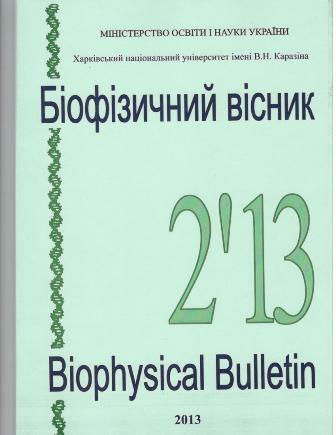The role of metal ions in the fibrillization of lysozyme and insulin in vitro
Abstract
The effects of metal ions on the fibrillization of lysozyme and insulin were investigated using a
Thioflavin T fluorescence assay and transmission electron microscopy. The incubation of the proteins in
acidic buffer at high temperature in the presence of substoichiometric concentrations of Сu2+, Zn2+, Fe3+
and Al3+ primarily led to the decrease in lag phase of fibril growth and protein aggregation rate compared to those in control samples. Furthermore, Сu2+ and Fe3+ showed a stronger influence on the protein fibrillization than Zn2+ and Al3+. Specifically, Сu2+ and Fe3+ provoked the formation of insulin amyloid fibrils, having a «fuzzy» appearance, while the amyloid-like insulin aggregates grew in the presence of Zn2+. These results highlight the potential of metal ions as prospective therapeutic agents against human«conformational» diseases.
Downloads
References
2. Swift B. Examination of insulin injection sites: an unexpected finding of localized amyloidosis / B. Swift // Diabet. Med. – 2002. – Vol. 19. – P. 881–882.
3. Role of metal dyshomeostasis in Alzheimer disease / D. J. Bonda, H. Lee, J. Blair [et. al.] // Metallomics. – 2011. – Vol. 3. – P. 267–270.
4. Iron and aluminum increase in the substantia nigra of patients with Parkinson's disease: an X-ray microanalysis / E. C. Hirsch, J. P. Brandel, P. Galle [et. al.] // J. Neurochem. – 1991. – Vol. 56. – P. 446–451.
5. Copper (II) inhibits in vitro conversion of prion protein into amyloid fibrils / O. V. Bocharova, L. Breydo, V. V. Salnikov [et.al.] // Biochemistry. – 2005. – Vol. 44. – P. 6776–6687.
6. Alies B. The role of metal ions in amyloid formation: general principles from model peptides / B. Alies, C. Hureau, P. Faller // Metallomics. – 2013. – Vol. 5. – P. 183–192.
7. Effect of environmental factors on the kinetics of insulin fibril formation: elucidation of the molecular mechanism / L. Nielsen, R. Khurana, A. Coats [et. al.] // Biochemistry. – 2001. – Vol. 40. – P. 6036–6046.
8. Metals and amyloid-beta in Alzheimer's disease / C. J. Maynard, A. I. Bush, C. L. Masters [et. al.] // Int. J. Exp. Pathol. – 2005. – Vol. 86. – P. 147–159.
9. Aluminum, copper, iron and zinc differentially alter amyloid-Aβ1-42 aggregation and toxicity / S. Bolognin, L. Messori, D. Drago [et. al.] // Int. J. Biochem. Cell Biol. – 2011. – Vol. 43. – P. 877–885.
10. Effect of Fe3O4 magnetic nanoparticles on lysozyme amyloid aggregation / A. Bellova, E. Bystrenova, M. Koneracka [et. al.] // Nanotechnology. – 2010. – Vol. 21. – P. 065103.
11. Metals accelerate the formation and direct the structure of amyloid fibrils of NAC / A. Khan, A. E. Ashcroft, V. Higenell [et. al.] // J. Inorg. Biochem. – 2005. – Vol. 99. – P. 1920–1927.
12. Copper is a potent inhibitor of the propensity for human ProIAPP1-48 to form amyloid fibrils in vitro / C. Exley, M. Mold, E. Shardlow [et. al.] // J. Diabet. Res. Clin. Med. – 2012. – Vol. 1. – P. 1–6.
13. Recent development of bifunctional small molecules to study metal-amyloid-β species in Alzheimer's disease / J. J. Braymer, A. S. Detoma, J. S. Choi [et. al.] // Int. J. Alzheimer’s Dis. – 2011. – Vol. 623051. – P. 1–9.
14. Hydrogen peroxide can be generated by tau in the presence of Cu (II) / X. Y. Su, W. H. Wu, Z. P. Huang [et. al.] // Biochem. Biophys. Res. Commun. – 2007. – Vol. 358. – P. 661–665.
15. Morante S. The role of metals in beta-amyloid peptide aggregation: X-Ray spectroscopy and numerical simulations / S. Morante // Curr. Alzheimer. Res. – 2008. – Vol. 5. – P. 508–524.
16. Tõugu V. Interactions of Zn (II) and Cu (II) ions with Alzheimer's amyloid-beta peptide. Metal ion binding, contribution to fibrillization and toxicity / V. Tõugu, A. Tiiman, P. Palumaa // Metallomics. – 2011. – Vol. 3. – P.250–261.
17. Faller P. Role of metal ions in the f-assembly of the Alzheimer’s amyloid-β peptide / P. Faller, C. Hureau, O. Berthoumieu // Inorg. Chem. – 2013. – Vol. 52. – P. 12193–12206.
18. Does aluminium bind to histidine? An NMR investigation of amyloid β12 and amyloid β16 fragments / P. Narayan, B. Krishnarjuna, V. Vishwanathan [et. al.] // Chem. Biol. Drug Des. – 2013. – Vol. 82. – P. 48–59.
19. Uversky V. N. Metal-triggered structural transformations, aggregation, and fibrillation of human alpha-synuclein. A possible molecular NK between Parkinson's disease and heavy metal exposure / V. N. Uversky, J. Li, A. L. Fink // J. Biol. Chem. – 2001. – Vol. 276. – P. 44284–44296.
Authors who publish with this journal agree to the following terms:
- Authors retain copyright and grant the journal right of first publication with the work simultaneously licensed under a Creative Commons Attribution License that allows others to share the work with an acknowledgement of the work's authorship and initial publication in this journal.
- Authors are able to enter into separate, additional contractual arrangements for the non-exclusive distribution of the journal's published version of the work (e.g., post it to an institutional repository or publish it in a book), with an acknowledgement of its initial publication in this journal.
- Authors are permitted and encouraged to post their work online (e.g., in institutional repositories or on their website) prior to and during the submission process, as it can lead to productive exchanges, as well as earlier and greater citation of published work (See The Effect of Open Access).





